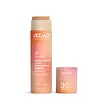What's inside
What's inside
 Key Ingredients
Key Ingredients

 Benefits
Benefits

 Concerns
Concerns

 Ingredients Side-by-side
Ingredients Side-by-side

Zinc Oxide 24%
Cosmetic ColorantVitis Vinifera Seed Oil
EmollientCaprylic/Capric Triglyceride
MaskingHelianthus Annuus Seed Wax
Skin ConditioningPropanediol
SolventMica
Cosmetic ColorantButyloctyl Salicylate
Skin ConditioningJojoba Esters
EmollientCI 77163
Cosmetic ColorantPolyhydroxystearic Acid
EmulsifyingCocos Nucifera Oil
MaskingCI 77492
Cosmetic ColorantHelianthus Annuus Seed Oil
EmollientOctyldodecanol
EmollientHydrolyzed Vegetable Protein
Skin ConditioningGlycogen
HumectantCI 77491
Cosmetic ColorantAcacia Decurrens Flower Wax
EmollientPolyglycerin-3
HumectantTocopherol
AntioxidantSilica
AbrasiveHydrogenated Lecithin
EmulsifyingTrihydroxystearin
Skin ConditioningCalcium Chloride
AstringentAscophyllum Nodosum Extract
Skin ConditioningCrithmum Maritimum Extract
Skin ConditioningFucus Vesiculosus Extract
EmollientLaminaria Saccharina Extract
Skin ProtectingPlankton Extract
Skin ConditioningAscorbyl Palmitate
AntioxidantZinc Oxide 24%, Vitis Vinifera Seed Oil, Caprylic/Capric Triglyceride, Helianthus Annuus Seed Wax, Propanediol, Mica, Butyloctyl Salicylate, Jojoba Esters, CI 77163, Polyhydroxystearic Acid, Cocos Nucifera Oil, CI 77492, Helianthus Annuus Seed Oil, Octyldodecanol, Hydrolyzed Vegetable Protein, Glycogen, CI 77491, Acacia Decurrens Flower Wax, Polyglycerin-3, Tocopherol, Silica, Hydrogenated Lecithin, Trihydroxystearin, Calcium Chloride, Ascophyllum Nodosum Extract, Crithmum Maritimum Extract, Fucus Vesiculosus Extract, Laminaria Saccharina Extract, Plankton Extract, Ascorbyl Palmitate
Water
Skin ConditioningGlycerin
HumectantDicaprylyl Ether
EmollientPentylene Glycol
Skin ConditioningPolyglyceryl-6 Distearate
EmulsifyingPropanediol
SolventCetyl Esters
EmollientJojoba Esters
EmollientCetearyl Isononanoate
EmollientBehenyl Alcohol
EmollientAcacia Decurrens Flower Cera
EmollientHelianthus Annuus Seed Cera
EmollientTriticum Vulgare Seed Extract
BufferingCentella Asiatica Extract
CleansingCeramide NP
Skin ConditioningSorbitan Oleate
EmulsifyingIsohexadecane
EmollientSodium Hyaluronate
HumectantSodium Stearoyl Glutamate
CleansingAdenosine
Skin ConditioningHydroxyacetophenone
AntioxidantHydroxypropyl Starch Phosphate
Capryloyl Salicylic Acid
ExfoliatingVitreoscilla Ferment
Skin ConditioningTrisodium Ethylenediamine Disuccinate
Polyglycerin-3
HumectantPolyglyceryl-3 Beeswax
EmulsifyingPolysorbate 80
EmulsifyingAcrylamide/Sodium Acryloyldimethyltaurate Copolymer
Emulsion StabilisingCetyl Alcohol
EmollientTocopherol
AntioxidantParfum
MaskingWater, Glycerin, Dicaprylyl Ether, Pentylene Glycol, Polyglyceryl-6 Distearate, Propanediol, Cetyl Esters, Jojoba Esters, Cetearyl Isononanoate, Behenyl Alcohol, Acacia Decurrens Flower Cera, Helianthus Annuus Seed Cera, Triticum Vulgare Seed Extract, Centella Asiatica Extract, Ceramide NP, Sorbitan Oleate, Isohexadecane, Sodium Hyaluronate, Sodium Stearoyl Glutamate, Adenosine, Hydroxyacetophenone, Hydroxypropyl Starch Phosphate, Capryloyl Salicylic Acid, Vitreoscilla Ferment, Trisodium Ethylenediamine Disuccinate, Polyglycerin-3, Polyglyceryl-3 Beeswax, Polysorbate 80, Acrylamide/Sodium Acryloyldimethyltaurate Copolymer, Cetyl Alcohol, Tocopherol, Parfum
 Reviews
Reviews

Ingredients Explained
These ingredients are found in both products.
Ingredients higher up in an ingredient list are typically present in a larger amount.
Jojoba Esters is a wax created from Jojoba oil. It is an emollient and film-forming ingredient. In bead form, it is an exfoliator.
This ingredient has high oxidative stability, meaning it doesn't break down when exposed to oxygen.
Its similarity to our skin's natural oils makes it a great emollient. Emollients help soften and soothe our skin by creating a barrier on top. This barrier helps trap moisture in, keeping skin hydrated.
It is created using either the hydrogenation or transesterification processes on jojoba oil.
Learn more about Jojoba EstersPolyglycerin-3 is a 3-unit glycerin polymer.
Like glycerin, this ingredient is a humectant. Humectants help hydrate your skin by drawing water to it.
Having moisturized skin helps improve the skin barrier. Your skin barrier helps protect against irritants and bacteria.
Learn more about Polyglycerin-3Propanediol is an all-star ingredient. It softens, hydrates, and smooths the skin.
It’s often used to:
Propanediol is not likely to cause sensitivity and considered safe to use. It is derived from corn or petroleum with a clear color and no scent.
Learn more about PropanediolTocopherol (also known as Vitamin E) is a common antioxidant used to help protect the skin from free-radicals and strengthen the skin barrier. It's also fat soluble - this means our skin is great at absorbing it.
Vitamin E also helps keep your natural skin lipids healthy. Your lipid skin barrier naturally consists of lipids, ceramides, and fatty acids. Vitamin E offers extra protection for your skin’s lipid barrier, keeping your skin healthy and nourished.
Another benefit is a bit of UV protection. Vitamin E helps reduce the damage caused by UVB rays. (It should not replace your sunscreen). Combining it with Vitamin C can decrease sunburned cells and hyperpigmentation after UV exposure.
You might have noticed Vitamin E + C often paired together. This is because it is great at stabilizing Vitamin C. Using the two together helps increase the effectiveness of both ingredients.
There are often claims that Vitamin E can reduce/prevent scarring, but these claims haven't been confirmed by scientific research.
Learn more about Tocopherol